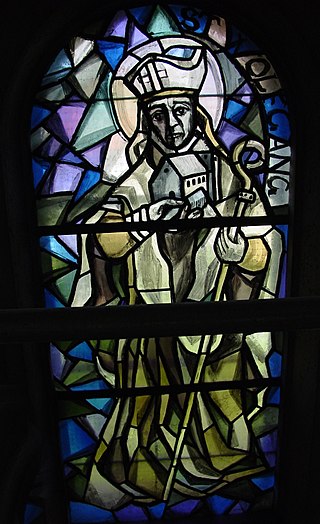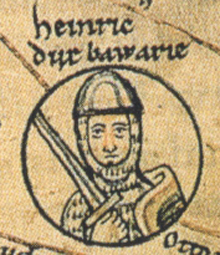Related Research Articles
Ezzo, sometimes called Ehrenfried, a member of the Ezzonid dynasty, was Count Palatine of Lotharingia from 1015 until his death. As brother-in-law of Emperor Otto III, father of Queen Richeza of Poland and several other illustrious children, he was one of the most important figures of the Rhenish history of his time.

Conrad I, called the Younger, was the king of East Francia from 911 to 918. He was the first king not of the Carolingian dynasty, the first to be elected by the nobility and the first to be anointed. He was chosen as the king by the rulers of the East Frankish stem duchies after the death of young King Louis the Child. Ethnically Frankish, prior to this election he had ruled the Duchy of Franconia from 906.

Wolfgang of Regensburg was bishop of Regensburg in Bavaria from Christmas 972 until his death. He is a saint in the Catholic and Eastern Orthodox churches. He is regarded as one of the three great German saints of the 10th century, the other two being Ulrich of Augsburg and Conrad of Constance. Towards the end of his life Wolfgang withdrew as a hermit to a solitary spot, in the Salzkammergut region of Upper Austria. Soon after Wolfgang's death many churches chose him as their patron saint, and various towns were named after him.

Henry I, a member of the German royal Ottonian dynasty, was Duke of Bavaria from 948 until his death.

Judith of Bavaria, a member of the Luitpolding dynasty, was Duchess consort of Bavaria from 947 to 955, by her marriage with Duke Henry I. After her husband's death, she acted as regent of Bavaria during the minority of her son Henry the Wrangler in 955-972.
Otto, son of Count Ricwin and a Liudolfing, was the Count of Verdun by inheritance and the Duke of Lorraine by appointment. Otto I, Holy Roman Emperor appointed him to Duke. Otto was a relative of the emperor, hence both his name and his appointment to high office. He is sometimes referred to as Otto I because another Otto later ruled over Lower Lorraine.

Gero was Archbishop of Cologne from 969 until his death.

Herman II, a member of the Ezzonid dynasty, was Archbishop of Cologne from 1036 until his death. According to historian Henryk Zieliński, Hermann was the most influential of the German metropolitans.
Tagino was the third Archbishop of Magdeburg from 1004 until his death.
Wichmann I the Elder was a member of the Saxon House of Billung. He was a brother of Amelung, Bishop of Verden, and Herman, Duke of Saxony.

The March of Zeitz was a march of the Holy Roman Empire. It was created by Emperor Otto I in the division of the marca Geronis in 965, following the death of Gero the Great. Its capital was Zeitz. Its first and only margrave was Wigger. In 982, Zeitz was reunited with the marches of Meissen and Merseburg under Ricdag, who thus temporarily reunited all of the southern marca Geronis save the Saxon Ostmark. In 983, Zeitz was overrun by the Sorbs and the marcher territory fell into the hands of the Slavs. Nevertheless, the march of Zeitz, along with the later March of Lusatia, was a recurring division of the Meissen march during the reign of the Emperor Henry II.

Wichmann II the Younger was a member of the Saxon House of Billung. He was a son of Count Wichmann the Elder and his wife Frederuna, a niece of Queen Matilda. The cousin of Emperor Otto I became known as a fierce enemy of the ruling Ottonian dynasty.
Aribo was the Archbishop of Mainz from 1021 until his death. He was Primate of Germany during the succession of Conrad II.

Thankmar was the eldest son of Henry I of Germany by his first wife, Hatheburg of Merseburg. His mother had been previously married and widowed, after which she entered a convent. Because she left the convent to marry Henry, her second marriage was considered invalid and the couple split. Thankmar's legitimacy was, therefore, in question.

Thietmar (II) (c. 945 – 3 August 979) was Margrave of Meissen from about 976 until his death.
Dedi was the Margrave of the Saxon Ostmark from 1046 and a claimant for the title of Margrave of Meissen from 1069. He was the second son of Dietrich II of Wettin and Matilda, daughter of Eckard I of Meissen.
Siegfried was the Count and Margrave of Merseburg from an unknown date before 934 until his death. He does not appear with the title of margrave in contemporary royal charters and diplomas, so the title was informal and never official.
Humfrid or Hunfrid was the archbishop of Magdeburg from 1023 until his death. He was with the court of the Emperor Henry III when, in the summer or 1040 the newly rebuilt church of Hersfeld was reconsecrated.

Meinwerk was the Bishop of Paderborn from 1009 until his death.

Adelaide I, a member of the royal Ottonian dynasty was the second Princess-abbess of Quedlinburg from 999, and Abbess of Gernrode from 1014, and Abbess of Gandersheim from 1039 until her death, as well as a highly influential kingmaker of medieval Germany.
References
- ↑ Manfred-Hiebl website, Gebhard I
- 1 2 Bernhardt, 101 and n62.
- 1 2 New Advent website, Ratisbon
- ↑ Bernhardt, John W. (1993). Itinerant Kingship and Royal Monasteries in Early Medieval Germany, c.936–1075. Cambridge Studies in Medieval Life and Thought: Fourth Series. Cambridge: Cambridge University Press. doi:10.1017/cbo9780511562372. ISBN 978-0-521-39489-5.